From curry-drenched rice dishes to superlative laksa to fried chicken, the meals that tell the rich story of Penang.
When the sun starts to set in George Town, bathing the colonial buildings in orange and pink, we step out into the street to hunt for dinner. Visitors to Penang never just have dinner; they hunt it, as if the meal were hiding in some darkened nook, guarded by a grey-haired auntie frying noodles.
We squeeze into the the open-air Line Clear restaurant, famous for one of Penang’s signature dishes: Nasi kandar, a heaped meal of rice with various curries and sides. Big metal trays and pots of curry grace a metal trolley along the wall, the oil congealing around the rims. A slim Indian man loads a plate with rice and begins ladling the contents of the pots over it.
“Won’t the sauces run together?” my friend asks.
“That’s kind of the point,” I say. The curries—red, orange, pink, and green—flood the long-grain rice in a muted rainbow, giving each bite a distinct and unexpected flavor.
Nasi kandar makes a messy but perfect allegory for Penang’s cultures and peoples, all splashed together on this island, fusing in some places, remaining more distinct in others. These cultures—Malays, Indian Muslims and Hindus, Thai, Chinese Hokkien, Cantonese, Teochew, Hakka, and Hainanese, and of course British colonialists—each contributed to Penang’s distinct cuisine, one that has made the island a hunting ground for the food-obsessed.
Pasembur at Kareem’s Pasembur Cart on Union Street

On July 17, 1786, the first man to step off the British sloop and wade through the surf—to the spot where Fort Cornwallis now stands—was an Indian sailor employed by Captain Francis Light, an unscrupulous trader and businessman working with the East India Company. For 15 years, Light had been negotiating with the Sultan of Kedah (the Malaysian province adjacent to Penang island) to make Penang a trading port, hoping to get filthy rich in the process.
Aboard his three ships were 100 Indian soldiers, known as sepoys, 30 Indian sailors from Madras, and 19 British officers and craftsmen. That first night, they likely ate something with curry. Within days, another group of Indians arrived; Muslim traders who had lived on the coastlines of Kedah for centuries, called Chulias, who were looking for new opportunities. They stayed, inviting friends and family to come and build the docks and work in the new port. Nasi kandar was invented at lunchtime down on the docks, when a man would carry two baskets—one of rice (nasi), one of curry—over his shoulder on a pole called a kandar.
Precisely when or where these Penang-based Indian Muslims invented pasembur is unclear, but that’s what I’m hunting when I leave touristy Fort Cornwallis and wander around the Queen Victoria Clock tower to a small, blue cart.
Kareem, the cart’s owner, is busy at lunch hour chopping fried tofu, egg, and a selection of fried seafood with a cleaver. He tosses the chunks onto a plate and mounds it high with shredded cucumber, jicama, and white potatoes, then floods the mixture in a bright red, curried tomato-peanut sauce, made thick and creamy by the addition of sweet potatoes. It’s a curried, creamy spin on rojak, a crunchy mix of vegetables and acidic fruits with peanut-shrimp-paste sauce found in Malaysia and Indonesia.
Assam Laksa, Everywhere
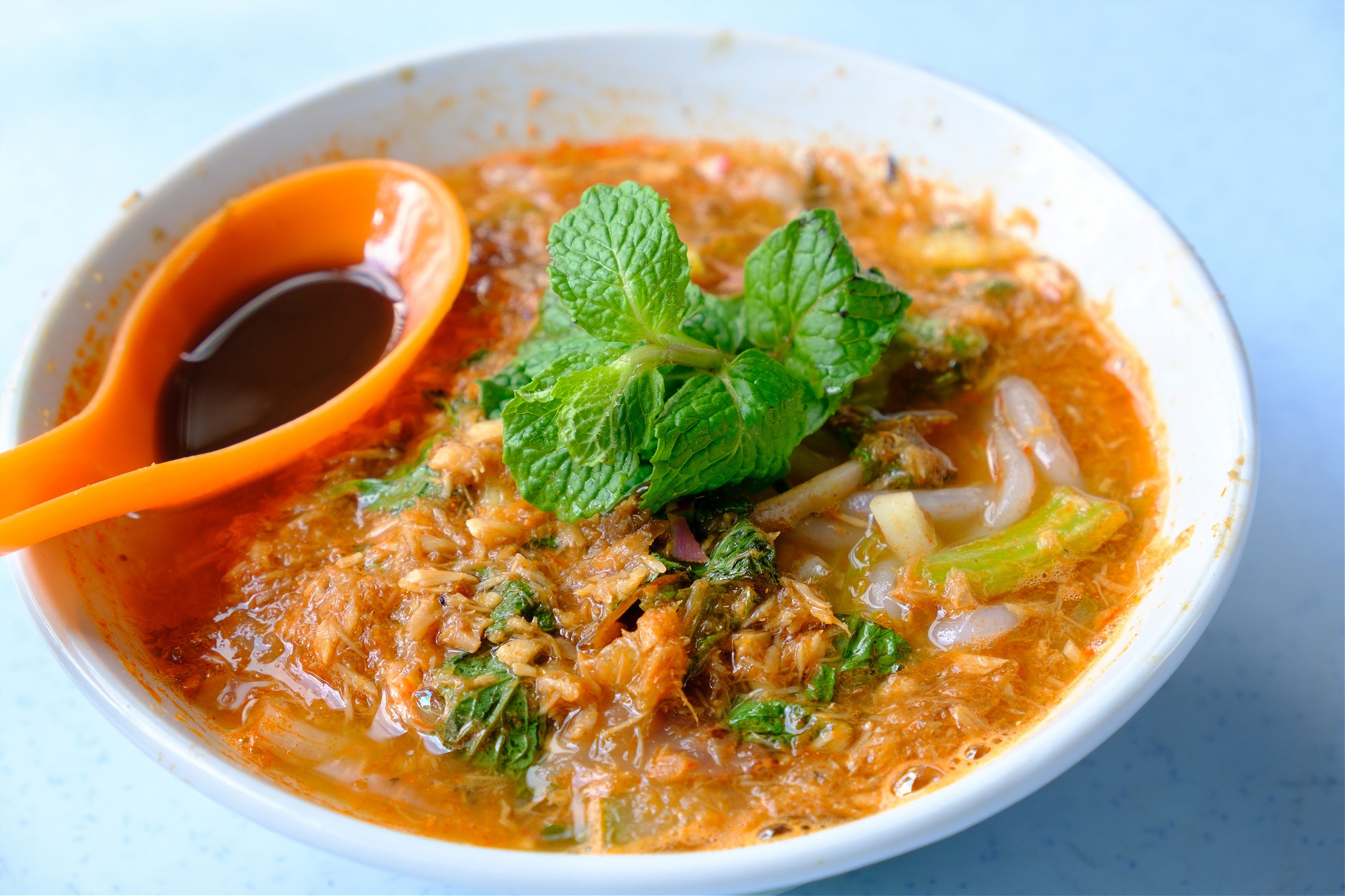
The day after Captain Light set foot in Penang, a wealthy Chinese merchant named Koh Lay Huan paid him a visit, offering a gift of three fishing nets. Koh and other Chinese merchants were unhappy with the Dutch trading monopoly over Sumatran ports and the increasing violence in Kedah and southern Thailand. They wanted to set up in Penang. Light realized he needed Koh’s help, and invited him to stay as the first leader, towkay or Kapitan, of Penang’s new Chinese community.
Koh was a pepper and shipping tycoon who had fled the Hokkien-speaking part of China and settled in Kedah decades before. With local wives in many ports, he was plugged into a community of wealthy Malaysian-born Chinese merchants, known as Peranakans or Baba-Nonyas, who had been living on the Thai and Kedah coasts for centuries—long enough to develop a fusion cuisine distinct from the Malaccan Peranakans living further south.
Even their laksa, a soupy noodle dish common throughout Southeast Asia, is different, made not with coconut milk but with tamarind. Penang’s assam (tamarind) laksa is a sweet-and-sour broth, infused with flaked mackerel and tinted fire-engine red by a mixture of chili and shrimp paste. Slippery, fat rice-noodles swim alongside handfuls of colorful herbs—lemongrass, galangal, turmeric, ginger flowers, shallots—all topped with a sprig of Vietnamese coriander (or laksa leaf) and finely sliced pineapple. The best way to sop up leftover broth is with popiah, a crunchy spring roll originating in Koh’s native Fujian province.
Hokkien Mee: Hae Mee and Loh Mee at Jelutong Market
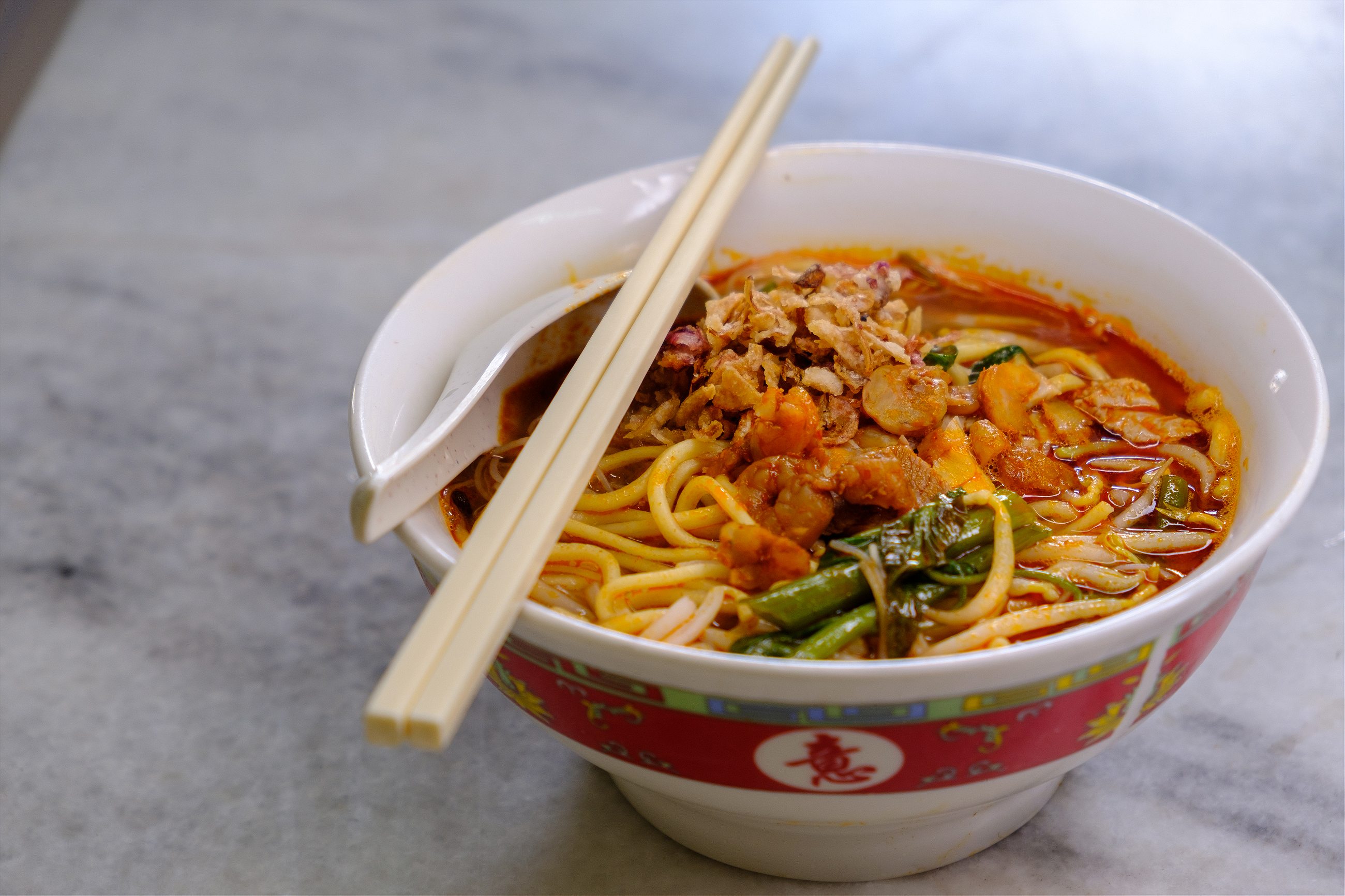
Hokkien Hae Mee and Loh Mee are types of noodle soup that immigrants brought to Penang from China’s Fujian Province—and possibly also, in the case of Loh Mee, from neighboring Guangdong province.
In the early 1800s, this southern region of China was deeply troubled. The rebellion against the Ming dynasty, the British Opium Wars, and the Taiping Rebellion encouraged Hokkien men to seek work in the tin mines in Phuket, or further south in Perak. When the Sultan of Kedah went to war with Thailand in 1821, local Thai-Malays, Peranakans, and new Hokkien refugees flooded into Penang. Eventually, the Sultan himself sought shelter on the island.
As the violence continued through the 1850s and 1860s, more refugees arrived directly from China, bringing with them the comforting noodle soups of their home. Hae Mee and Loh Mee use the same mix of noodles for extra slurpiness, but have different broths. Hae mee, known in Penang as “Hokkien Mee,” or “Hokkien Prawn Noodle,” is a thin broth of simmered shrimp heads, tails, and pork bones with onions and garlic, tinged orange from chili paste. The broth is ladled over the noodles with a random selection of hard-boiled egg, smoked pork belly, fried mantis shrimp, a token handful of local water spinach, kangkung, for color, and sometimes chicken feet or intestines. Loh Mee is thickened with corn starch, darkened with soy sauce, and flavored with Chinese five spice. It’s sold right alongside Hokkien Mee, and it’s totally fine if you want to mix the two kinds of broths together for a local-style bowl of Hokkien cham lor.
Chee Cheong Fun outside Seow Fong Lye Café

Malaysia’s traditional coffee shops, kopi tiams, don’t serve food. They serve about a dozen kinds of coffee and tea, and the food comes from the independent stall-holders who pay rent to cluster their stalls around the coffee shop, making each kopi tiam more like a food court or hawker center.
When I go with friends to chat over a hot cup of coffee, I like to order chee cheong fun. The rubbery rice noodles, thick like spring rolls and doused with a Penang-specialty sauce, owe their popularity to the Cantonese, a minor (in number) but important immigrant group, who brought with them wonton noodle soup, dim sum, and chee cheong fun. Elsewhere, chee cheong fun comes with simple soy sauce, sweet bean paste, or even curry, but in Hokkien-influenced Penang, the chee cheong fun can only be paired with prawn paste, sugar, dark soy sauce, and a sprinkle of sesame seeds.
Many Cantonese migrants had been powerful merchants based in Guangzhou. After the British captured the city in 1841, many of them fled to Penang, and eventually became embroiled in the tin-mining wars, which pitted groups against each other along clan lines and secret societies. The Hokkien tin tycoons fought the Cantonese. The Cantonese fought the Hakka-Chinese, and so on. Nowadays, though, everyone seem to get along just fine over a plate of chee cheong fun.
Roti Canai with Teh Tarik at Sri Ananda Bahwan

Although Indians were present in Penang from its inception, until 1884 the majority were Muslim: South Indian sepoys and Chulia merchants, shop-owners, moneylenders, and dockworkers. It wasn’t until after 1884, when the British finally legalized Indian immigration, that more South Indian Tamils—both Muslim and Hindu—started arriving in Penang to work as laborers on the coconut, sugar, coffee, and opium plantations.
Tamil Muslim and Tamil Hindu cuisines are very different, the former meat-heavy, but both Mamaks (Tamil Muslim restaurants) and Hindu “banana leafs,”—vegetarian-friendly restaurants that traditionally used banana leaves as plates—serve the quintessential Penang breakfast: roti canai and a mug of teh tarik, a mixture of Black English tea and condensed milk.
Sri Ananda Bahwan is a banana leaf in George Town’s Little India. The serving counter is laden with spicy vegetable scrambles, daals, coconut sambal, and mint chutney, as well as chicken curry and paneer, the air fragrant with mustard and anise seeds. In the front behind a glass window, a man is bare-knuckling the spongy roti canai dough, getting ready for the breakfast spread.
In the Malay language, canai means to flatten, smooth, or thin. The man slaps and whirls the dough, dusting his apron with white flour, and tosses the large discs onto a hot-oiled griddle, where they sizzle and begin to swell under their browned spots, drying into a flakey, buttery flatbread. We tear it into strips to soak up the sauces and wash it all down with the teh tarik.
Char Koay Teow at Siam Road Charcoal Char Kway Teow
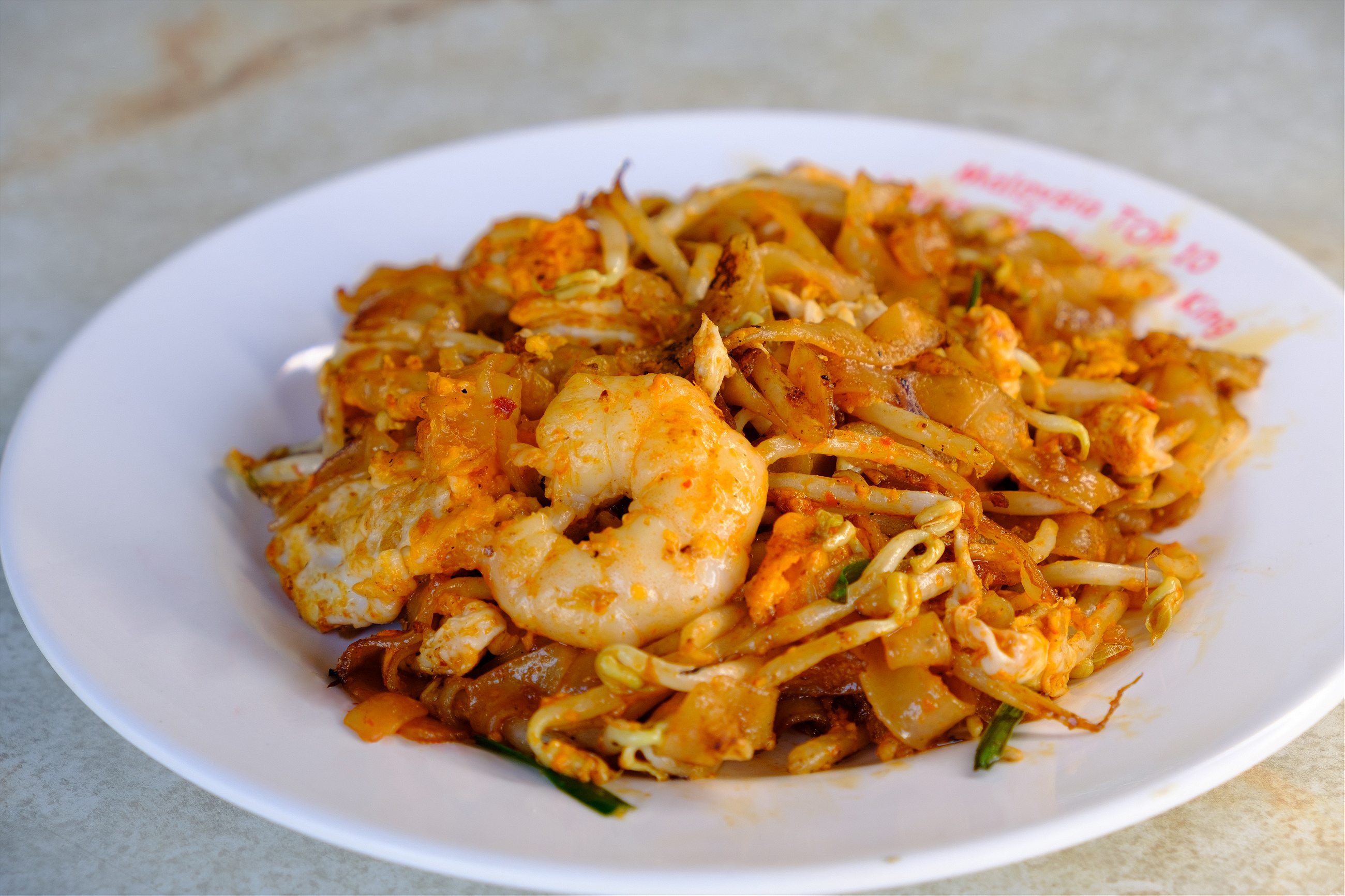
Outside Hock Ban Hin coffee shop, an old man fans flames with his left hand as his right whips noodles around a blackened wok with a metal spatula. He pushes the noodles to one side and adds an egg, breaking the yolk apart and stirring it into the glistening noodles. A handful of bean sprouts, a squirt of dark soya sauce, a pinch of chives, and then he scrapes the steaming soft mess onto a pink plastic plate and starts all over again. He makes each batch separately and serves it piping hot, glistening, and butter-soft with pork lard and chili paste.
The Teochews, a Chinese immigrant group from the region between the Hokkien and Cantonese homelands, fled the same wars and violent unrest. But they were farmers, and they came to Penang to farm. This pleased the British, because someone had to grow food and tend the coconut, sugar, opium and coffee plantations.
In 1855, a group of six Teochew men opened a lodging house on Beach Street to help newly-arrived Teochew immigrants get a foothold. Even though their numbers were never large—today Teochews comprise just 18 percent of Penang’s Chinese population—they brought to Penang their respect for vegetables and egg dishes (such as oyster omelets), and their own type of noodle, called kway teow. Teochew noodles are slim, slippery flat rice noodles with an elastic bounce. Stir-fried over the high heat of a charcoal fire, the paper-thin noodles caramelize and sweeten, releasing a tantalizing aroma known as wok hei. It’s why the best char koay teow stalls still use a charcoal fire, even if a gas flame would be more convenient. Char koay teow is the ultimate comfort food for many Penangites, served late in the afternoon and into the wee hours of the night with an iced cup of iced coffee.
Kopi-C and Kaya Toast at Toh Soon Cafe

Ordering a cup of coffee in Malaysia can be complicated. A traditional kopi tiam typically offers a dozen variations of a dark, syrupy roast that hits the back of your tongue with the richness of chocolate. The basic cup comes loaded with condensed milk, while kopi-c adds sugar, kopi-peng ice. To make it vegan, say kopi-o. Watching your carbs? Say kopi-kosong. Want it black? Get a kopi-o-kosong.
The Hainanese began opening kopi tiams at the turn of the century. The story goes that, as the last Chinese immigrants to arrive in Penang, there wasn’t much work left for them. The Hokkiens and Cantonese controlled the ports and the mines, the Teochews had the plantations on lockdown. But the Hainanese could cook. Many found work as cooks in British kitchens and military outposts, while others mastered local dishes and opened food stalls and kopi tiams. Although they comprise only 1.8 percent of today’s Chinese population, many Penang dishes have a pinch of Hainanese influence, and Penang’s contemporary obsession with coffee, chic cafes, and a unique type of roast is likely thanks to the Hainanese, who started to arrive in Penang in the late 1880s just as Malaysia’s budding coffee industry reached its boom years.
Malaysians grew Liberica beans, a sturdy species grown almost nowhere else. Today, Liberica comprises just 2 percent of the world’s harvest, almost all of it grown in Indonesia or Malaysia. Liberica is smoky, nutty, rich and exceptionally bitter, like baker’s chocolate. But it’s not just the Liberica beans. Hainanese coffee is special, roasted in margarine and sugar until the beans cling together like tar, then ground and placed into a muslin bag through which hot water is poured. It’s served alongside thick slabs of fluffy white bread, grilled over an open fire and smeared with kaya, a fluffy coconut jam sold at any Hainanese kopi tiam or restaurant, where Penangites got their first taste of Western-style cuisine.
Hainanese Chicken Chop at Yeng Keng
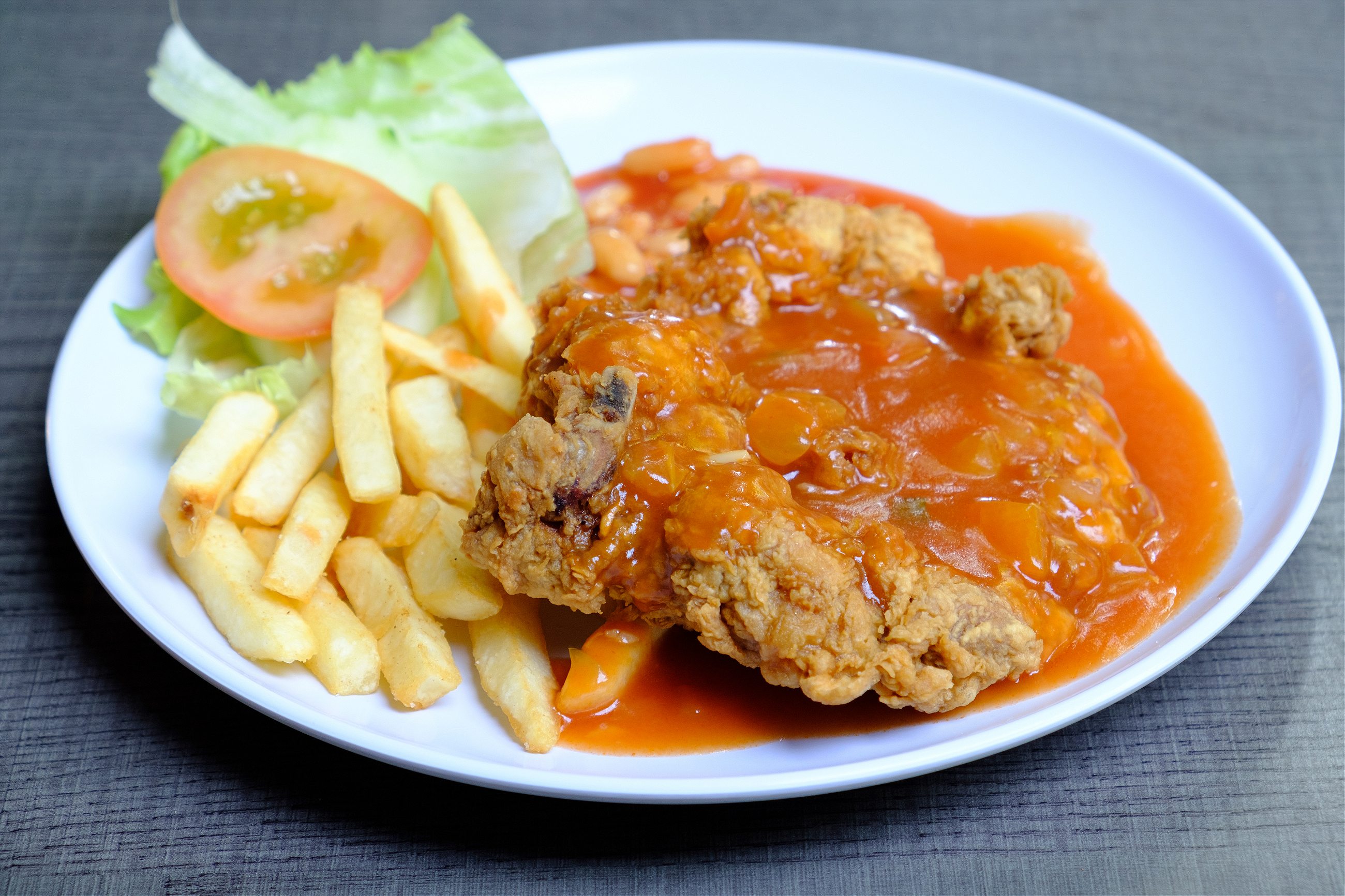
In 1867, Britain took direct control of Penang from the East India Company, and more British citizens came to British Malaya, as the British-controlled territories in the Malay peninsula were then called. Then in 1915, during World War I, 850 Indian sepoys in Singapore mutinied. The British fired the sepoys, sent more British troops to the region, and hired more Hainanese cooks.
The cooks had a challenging job—devising meals palatable for the newly arrived British soldiers, who complained bitterly about the lack of English meat and the strangeness of the local fare, heavy with chicken feet, intestines, offal, and too many spices. The one thing that made them happy was fried chicken—a dish now known locally as chicken chop. It’s simply battered and fried chicken, served with brown gravy and sides of fries, baked beans, and a mayonnaise-rich salad.
Everything that they served to the British, the Hainanese introduced in their kopi tiams. They brought in buttered toast, chicken pot pie, and dozens of other staples that both British citizens and Penang’s rock-and-roll-obsessed youth grew to love in the 1940s and 50s. But yesterday’s youth are old today, and the old-style Hainanese kopi tiams are becoming a thing of the past, replaced by the newest fads and trends.
Nasi Lemak at Ali Nasi Lemak Daun Pisang, Sri Weld Food Court
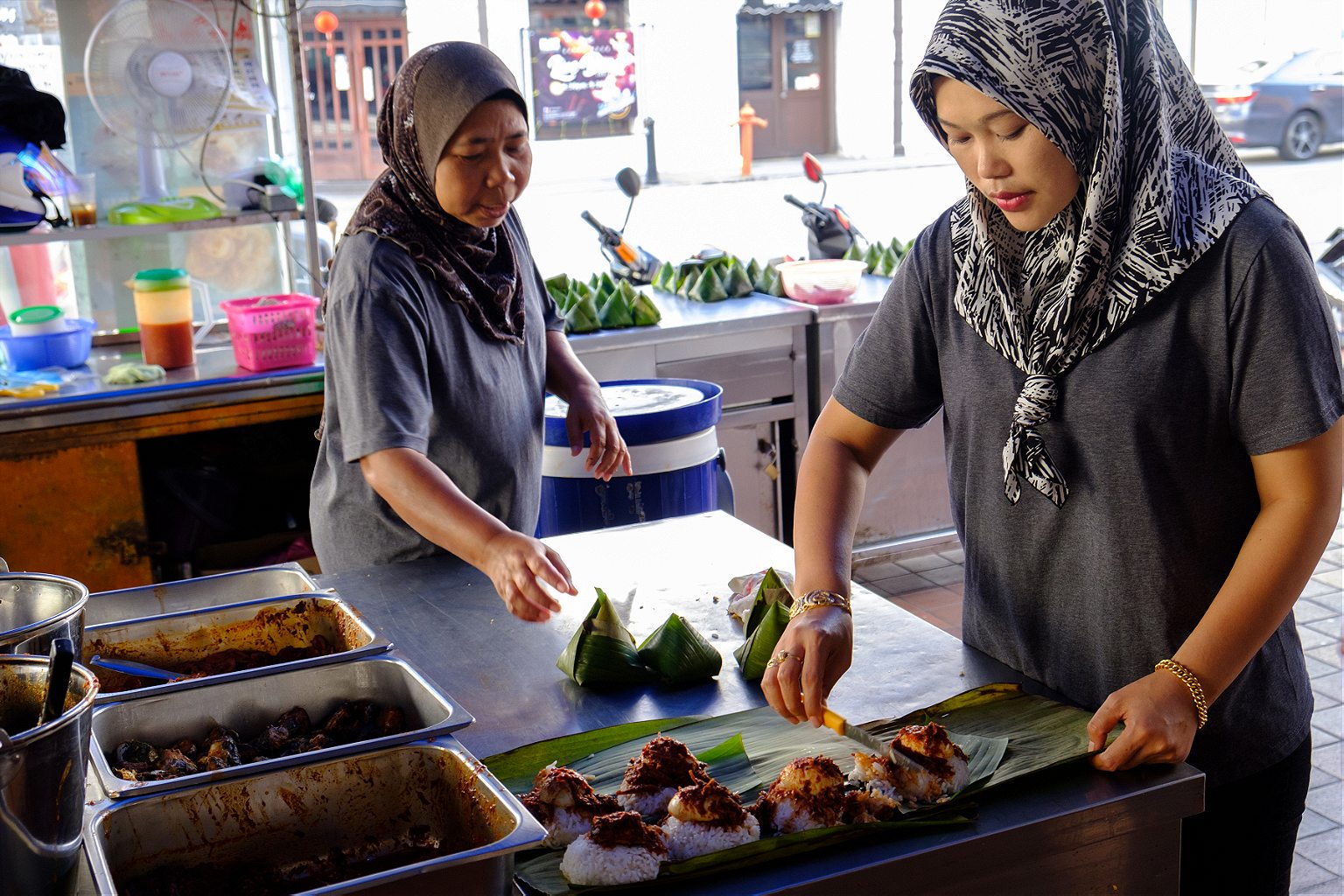
On Aug. 31, 1957, Malaysia declared independence from Britain. Penangites weren’t sure what they wanted to do. Penang was culturally different from the rest of Malaysia, with a population 73 percent Chinese and about 10 percent Indian. Some wanted to remain autonomous, or join forces with Singapore. Some worried Penang would change. Of course, it would.
Penang’s population has doubled since 1957. In 2010, Malays outnumbered the Chinese for the first time in Penang’s history. Penangites today identify more as Malaysian than as Hokkien or Cantonese or Tamil. They are as proud of their heritage, and their diverse cultures and cuisines, as they are of the Malaysian national dish: nasi lemak.
This being Penang, where hunting the best version of each dish is something of a local pastime, people have opinions on the ‘right’ way to make nasi lemak, and the ‘best’ stall to hunt down, compare, and argue over good-naturedly with friends. My local friends prefer Ali’s, a food cart at the Sri Weld Food Court.
At Ali’s, the base of the dish is a triangle of coconut rice, steamed to salty perfection, with a twist of pandan leaf, and topped with a thick, spicy shrimp sambal that stains the rice red. Half a hard-boiled egg and salty anchovies go on top, packed so tightly inside the banana leaf that the ingredients hold together in a perfect pyramid when you unfold it.
Others may argue that the best nasi lemak is in the Taman Perak neighborhood, where it can sell out as early as 7 a.m., or at Red Hat Auntie’s—either in spite of or because of her infamous moodiness—or the little stand on the corner of Love Lane and Chulia Street. But that’s the fun of the hunt: in Penang, there’s always the promise of something tastier just around the corner.